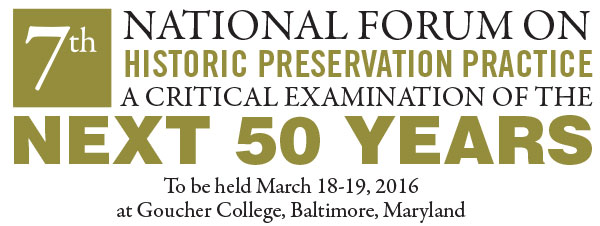Next year marks the 50th anniversary of the 1966 National Historic Preservation Act. The law responded admirably to the many challenges facing our nation’s historic patrimony 50 years ago. As our nation celebrates the law’s half-century mark, the question arises – what will the next half-century hold for historic preservation policy and professional practice in the United States? Will the way we now conduct or even define historic preservation change? Much will change in the next half-century. Will the old policies, and practices still work? If not, what are the models?

The 7th National Forum on Historic Preservation Practice will explore our future within the context of five significant drivers that will shape our future: demographics, economics, environment, technology, and education.
The 7th National Forum on Historic Preservation Practice: A Critical Examination of the Next 50 Years, to be held March 18-19, 2016, seeks to explore multiple answers and perspectives to such questions as:
Will the nation’s expected “majority/minority” population shift, decline in fertility rates, and longer lifespans impact historic preservation practice?
How will historic preservation practice and policies change in response to a post- service/co-production economy, changes in monetary and banking systems, and changes to the tax codes, among other economic trends?
How will advances in science, information technology, and communication affect the professional practice of historic preservation?
How should historic preservation practice response to the effects of environmental change? Should there be better integration between natural conservation and historic preservation?
How will historic preservation education better prepare professionals for the future of preservation practice?

The 7th National Forum seeks diverse answers to these complex questions through plenary presentations from “futurists” experts, 15 competitively selected papers, and robust attendee discussion. Forum attendance will be limited to the first 150 paid registrations to allow dynamic discussion among attendees.